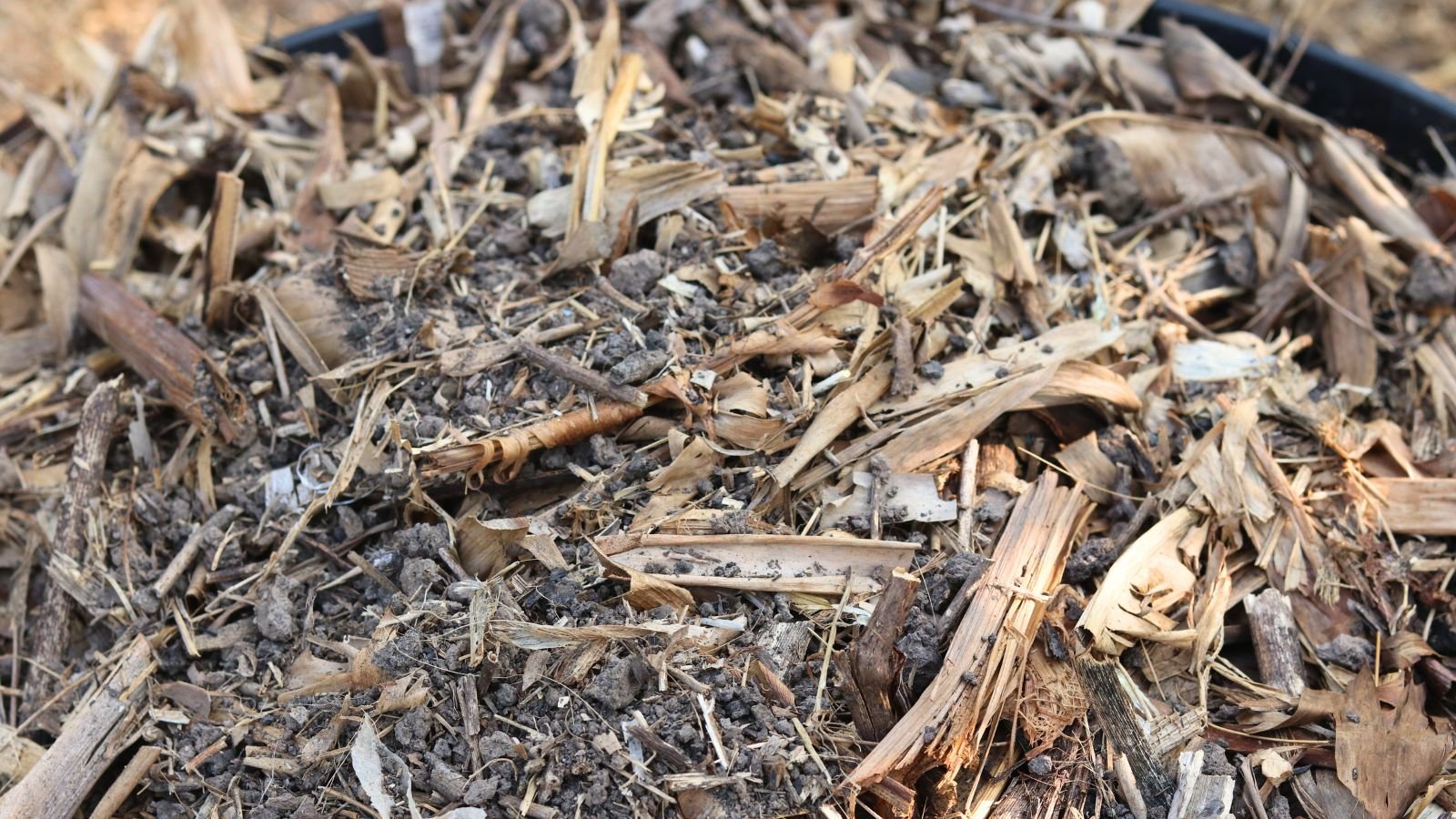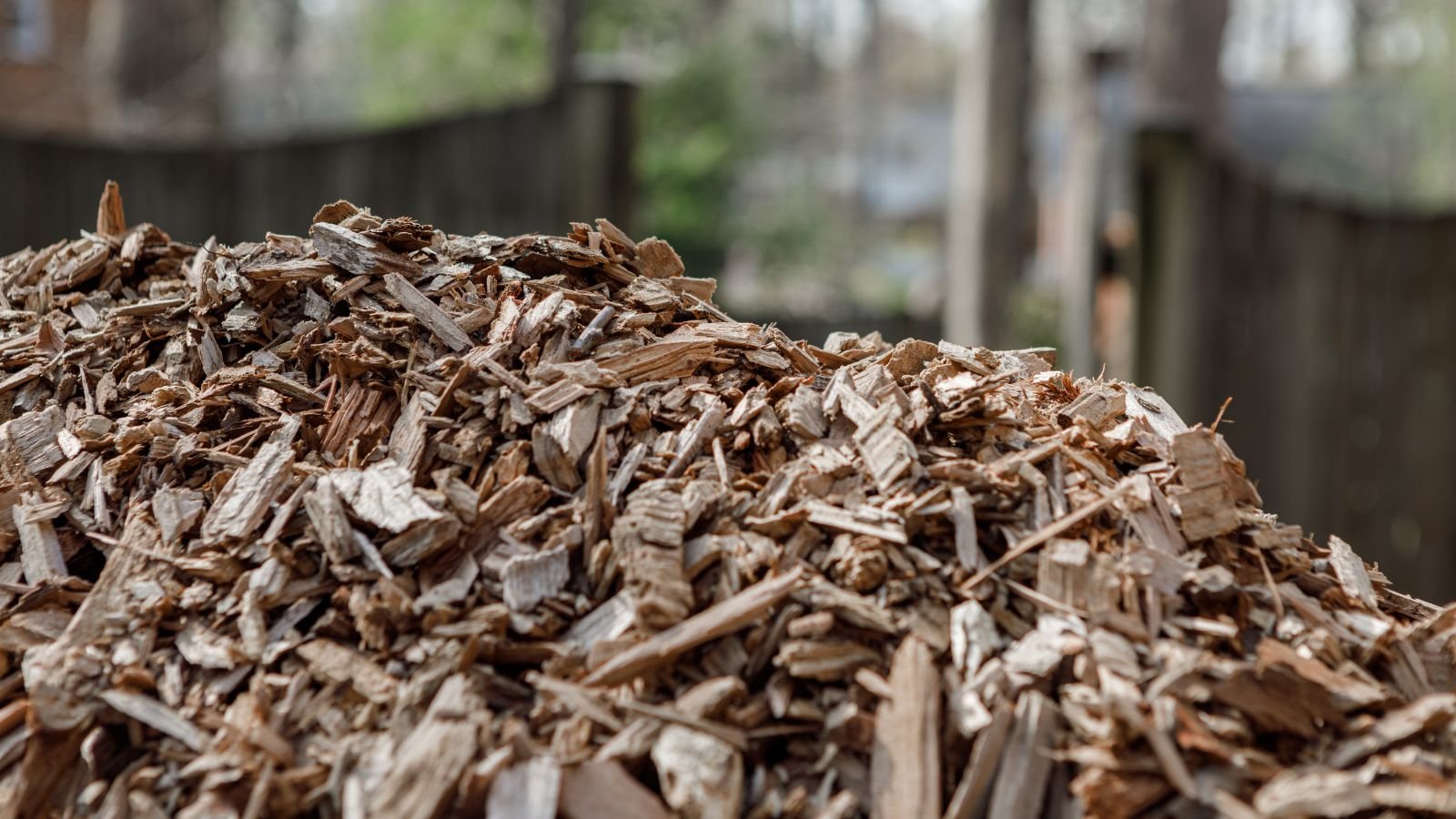Ramial Chipped Wood: How to Use it in Your Garden
Ramial chipped wood adds a boost to your garden, but what is it and how does it work? Gardening expert Kelli Klein explains all you need to know about this resource.

Contents
Ramial chipped wood differs from arborist wood chips and other types. Unlike arborist’s chips, ramial chips come from slender green branches, typically less than a quarter inch in diameter. These chips can also include organic matter, such as green leaves and young shoots.
But why use this type of wood? The answer is simple: the young, green shoots of trees are the most nutrient-dense parts. Since the tree is actively fueling its growth in these areas, they provide the highest-quality chips for fungal development. If you’re doing light pruning, turning those fresh shoots into chips offers an excellent resource for soil enrichment.
Fungi play a crucial role in forest and active soils. Feeding them with ramial chips supports their growth, ultimately improving soil health. As these chips break down, they release nutrients directly into the soil, supporting plant growth.
Bark and trunk chips are still valuable mulching materials. However, ramial wood stands out as the highest-quality option due to its selective sourcing.
Because ramial chipping involves pruning young wood and shoots, it allows gardeners to easily separate out diseased material, ensuring only the healthiest, most nutrient-dense chips make it into the mix. This makes ramial chips an excellent resource for organic gardeners focused on soil health.
All About Ramial Wood Chips

Ramial chipped wood, sometimes referred to as BRF (bois raméal fragmenté in French), is a type of wood chip made from the small to medium-sized branches of young trees. The sapwood and young branches of hardwood trees like yellow birch, oak, chestnut, maple, and beech are the most desirable. These small branches are higher in nitrogen, allowing them to decompose quickly and contribute to healthy soil faster than older wood.
Using both small branches and fresh leaves helps retain soil moisture, moderate pH, reduce pathogens, and increase earthworm populations. In orchards, young branches can be ‘chopped and dropped’ like a cover crop beneath fruit trees, serving as a beneficial ramial mulch.
Benefits of Ramial Wood Chips

The positive impact of adding ramial wood chips to your garden includes the production of humic substances. Decomposing fungi that break down these wood chips fall into two main subgroups.
White rots use enzymatic amino acid chemistry on lignin-rich hardwood to produce humic and fulvic acids. Humic acid enhances nutrient uptake, drought tolerance, and seed germination. It also increases microbial activity in garden soil.
Brown rots, on the other hand, break down softwood cellulose to produce polyphenols and allelopathic compounds. These compounds, particularly in evergreen species, suppress deciduous plant growth and can aid in weed suppression.
Additionally, new research suggests that soil microbes metabolize polyphenols in a way similar to how the human gut processes them.
The science behind this approach comes from studying hardwood forests. Deciduous trees continuously enrich the soil they grow in. This contrasts with conifer-dominated forests, such as those of pine and cedar, which degrade soil over time to outcompete non-conifer species.
In the mid-1970s, Edgar Guay, former Land and Forest Deputy Minister in Quebec, began searching for ways to repurpose the large piles of branches left behind after logging operations. The first field experiments with deciduous tree trimmings took place in the summer of 1978.
By 1982, M. Gilles Lemieux had begun researching the role of trees in soil fertility at Laval University. He observed that most forests are self-fertile and that the most nutrient-rich soils on Earth come from forests. Lemieux referred to this concept as Jean Pain, which led him to further study RCW (Ramial Chipped Wood). He also discovered that the addition of ramial wood chips can help raise the pH of acidic soils.
Ramial Wood Chips vs. Arborist Wood Chips

Technically speaking, ramial wood chips are made specifically from the slender twigs of young trees and may include foliage.
Arborist wood chips, commonly used for pathways and mulch, may contain some ramial wood. But they also include larger branches and trunk wood from a given tree-trimming job. While these wood chips are perfectly fine to use, they don’t have the same properties as ramial wood chips. They tend to be less nutrient-dense, higher in carbon than nitrogen, and sourced from larger-diameter wood.
A major advantage of arborist chips is that they are often free, as tree trimmers need to dispose of their waste product without paying for removal. If your neighbor is having a tree trimmed, the arborist may even be willing to chip the branches directly into your yard. Additionally, free chip subscription services allow you to be added to a waiting list to receive a chip drop when an arborist in your area has excess mulch to offload.
Other Types

Traditional bark chips come from, as the name suggests, tree bark. These chips are usually a byproduct of the commercial logging industry and are commonly found in big-box stores sold as mulch. They are available in two main forms: chipped bark and shredded bark.
Shredded bark is particularly useful for weed suppression on farms, as it forms a dense mat that makes it difficult for seeds and roots to penetrate. However, bark chips are the least nutrient-dense type of wood mulch since they come from the outer part of the tree.
It’s also worth noting that not all commercial brands are created equally. Some contain artificial dyes, which may not be ideal for use around edible plants. Farmers may also avoid certain brands for this reason.
DIY Ramial Wood Chips

Farmers may choose to chop and drop young shoots around the base of trees as a rustic form of mulch. This method is fine, though the shoots will break down slowly unless they are thoroughly chipped.
If you or a neighbor are pruning a hardwood deciduous tree, set aside the slender young shoots, small branches, and twigs to turn them into ramial chipped wood. Commercial-grade chippers are available for rent at big-box stores. It may be worth considering if you have a large amount of pruning to process.
How To Use Ramial Wood Chips
Now, let’s explore different ways to use ramial wood chips in the garden. They can serve as filler in landscaping, enhance moisture retention in vegetable gardens, enrich soil in raised beds, and boost compost by adding green materials.
While ramial wood chips have many applications in gardening and landscaping, we’ll focus on the two most popular uses here.
In the Vegetable Garden

When using wood chips in the vegetable garden, it’s important to allow the soil time to ‘digest’ the material for a few months. If not, the decomposition process could temporarily deplete nitrogen levels, requiring additional supplementation. This occurs because wood requires nitrogen to break down.
However, as the wood decomposes, the nitrogen is gradually released back into the soil. Professor Lemieux recommended incorporating fresh ramial wood chips into the soil in the fall. Since fungal mycelia are not significantly slowed by cold conditions, they continue breaking down the chips throughout winter. By spring, any risk of nitrogen deficiency will have passed, and the soil will be ready for planting.
To use this method, spread a thin layer of chips over the planting site in the fall after clearing the beds. By spring, the mulch will be well decomposed.
Some gardeners wonder if composting ramial wood chips before adding them to garden beds is necessary. When following the fall application method, pre-composting isn’t needed. However, if you receive ramial wood chips in spring or summer and wish to use them during the same growing season, you may choose to pile them for a few weeks to start decomposition before adding them to your beds.
Ramial wood chips decompose more quickly than chips from older wood but at a slower rate than traditional compost. Pre-composting can help accelerate their breakdown. Incorporating ramial wood chips into a vegetable garden enriches soil organisms and builds healthy, nutrient-dense soil.
Studies have also shown that using RWC reduces pest populations while increasing the presence of beneficial insects. Supporting a thriving garden ecosystem starts with a soil microbiome rich in nutrients!
Filler For Landscaping

Ramial wood chips are especially useful for improving poor soil and suppressing weeds and invasive plants. They help restore soil structure, increase drought resistance by retaining moisture, and smother unwanted vegetation.
They can also prevent soil erosion on sloped areas by protecting the top layer of soil from washing away. This is particularly beneficial for sections of the garden that are not currently in use or are unsuitable for cultivation due to poor soil, insufficient sunlight, or susceptibility to flooding.
If you have an unused area that you’d like to prepare for future planting, apply a thick layer (at least four to six inches) of ramial wood chips and allow them to decompose naturally, enriching the soil over time. When using the mulch to suppress weeds or invasive plants, adding an extra barrier improves long-term effectiveness.
For best results, lay a layer of cardboard flat over the area before applying wood chips. This combination effectively smothers weeds while keeping the soil protected. Since bare soil tends to attract weeds and invasive plants once disturbed or left uncovered, this method helps maintain a healthier growing environment.
In addition to soil restoration, ramial wood chips can be used as traditional mulch around tree bases, between ornamental plants, or as decorative pathways in landscaping designs. As they break down, they provide a steady source of nutrients, further enriching the garden ecosystem.
Frequently Asked Questions
How long does it take for chipped wood to decompose?
As a part of a regularly turned compost pile, they can decompose on the ground within about 90 days, especially during the heat of the summer. Spread it as mulch, and left unturned, the material can decompose in about 6 months.
Can I put topsoil over wood chips?
Technically, yes, but whether or not you want to all depends on what/if you’ll be planting in that location. Some plant roots and vegetables are sensitive to disturbances in the soil (i.e., carrots and other root vegetables, which need light obstruction-free soil in order to grow properly). Other plants like stonecrops prefer rocky, well-draining soil. If you aren’t planting at that location for a while the chip is likely to decompose within a few months.
Do wood chips make good fill?
Yes! If you have an unused area of your garden, then using wood chips as fill material is a great way to protect the soil from erosion and unwanted weed/invasive plant growth. They can be used to improve material soil quality for future plantings as well.
Do fresh wood chips attract termites?
Ramial chipped wood and twigs are not necessarily an attractive source of food for termites. However, they do provide their ideal habitat by maintaining a high level of soil moisture. If you’re worried about termites infesting your home, be sure to keep a perimeter around your home clear of wood chips and provide good drainage away from the foundation.
How deep should wood chips be?
4 to 6 inches deep will help smother weed seeds and protect the soil by repairing the soil structure as they break down.
Do weeds grow through wood chips?
Wood chips are an excellent natural method of weed control, especially when applied to the above-recommended depth. However, some very stubborn weeds and invasive plants may still find a way to put down roots and grow through your wood chips.









